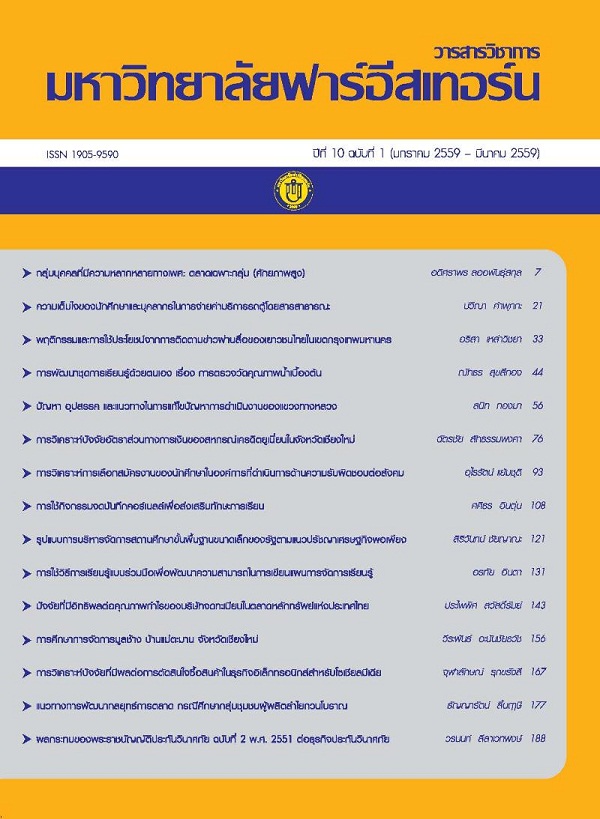การศึกษาการจัดการมูลช้าง บ้านแม่ตะมานจังหวัดเชียงใหม่
Main Article Content
Abstract
การวิจัยครั้งนี้เป็นการวิจัยเชิงปฏิบัติการแบบมีส่วนร่วม เก็บรวบรวมข้อมูลโดยการสังเกต การสอบถาม
และการสนทนากลุ่ม การวิจัยได้มีการแบ่งออกเป็น 2 ช่วง กล่าวคือ ระยะที่ 1 เป็นขั้นตอนการเตรียมการวิจัยโดย
การจัดประชุมกลุ่มผู้นำ ระยะที่ 2 กิจกรรมติดต่อผู้เชี่ยวชาญของสำนักงานพลังงานลำพูน และสำนักงานพลังงาน
เชียงใหม่ ทดลองการสร้างบ่อแก๊สชีวภาพต้นแบบ ทำการสำรวจข้อมูลเชิงลึกในส่วนของการสร้างบ่อแก๊สชีวภาพของ
ชาวบา้ น สรา้ งบอ่ แกส๊ ชีวภาพเพิ่มเติม อบรมเรื่องการใชบ้ อ่ แกส๊ ชีวภาพ ประชุมจัดตั้งกลุม่ ที่มีบอ่ แกส๊ ชีวภาพ สรุปบทเรียน
และตรวจสอบความถูกต้องของข้อมูลการวิจัยร่วมกับชาวบ้านแม่ตะมาน เป็นระยะเวลา 5 เดือน
ผลการศึกษาพบว่า บริบทของบ้านแม่ตะมาน เป็นหมู่บ้านที่ได้มีการพัฒนาให้เจริญเติบโตรุ่งเรื่องมาตลอด
มีถนนลาดยางแอสฟัสต์เข้าหมู่บ้าน มีความเจริญด้านสาธารณูปโภค มีสถานที่ท่องเที่ยวที่สร้างชื่อเสียงและรายได้
ใหกั้บประเทศในแตล่ ะปจี ำนวนมากก็คือ ปางชา้ ง มีทีพัก โรงแรม รีสอรท์ สปา และโรงเรียนบา้ นแมต่ ะมาน ตั้งอยูเ่ลขที่
7 หมู่ 2 ตำบลกื้ดช้าง อำเภอแม่แตง จังหวัดเชียงใหม่ ปัจจุบันมีจำนวนนักเรียนทั้งหมด 139 คน จำนวนครู 13 คน
และมีนาย ณัฐวรรธน์ ดอนดี เป็นผู้อำนวยการโรงเรียน กลุ่มคนฮักป่า เป็นกลุ่มที่ก่อตั้งขึ้นเมื่อปี พ.ศ. 2553 โดย
นายเสถียร ใจคำ นายกองค์การบริหารส่วนตำบลกื้ดช้าง โดยมีหน้าที่หลัก คือ การรณรงค์ให้ความรู้กับเยาวชน และ
ชาวบ้านในเรื่องการอนุรักษ์สิ่งแวดล้อม ปัจจุบันมีนายสุนทร กอนจม เป็นประธานกลุ่ม สภาพปัญหามูลช้างที่เกิด
ขึ้นภายในหมูบ่ า้ นแมต่ ะมาน โดยสว่ นใหญมี่มูลชา้ งเกิดขึ้นตอ่ วันเปน็ จำนวนมากถึง 9,160 กิโลกรัม โดยคำนวณจาก
ช้าง 5 ปาง คือ ปางช้างแม่ตะมาน ปางช้างแม่แตง ปางช้างโชคชัย ปางช้างแอลลี่ ปางช้างบ้านช้างไทย มูลช้างทั้งหมด
จะถูกกำจัดโดยวิธีการ เอาไปกองไว้ที่บนดอยเพื่อให้การย่อยสลาย การนำเอาไปทิ้งในสวนของชาวบ้าน เนื่องจาก
ชาวบ้านมาขอ แต่มูลช้างบางส่วนที่อยู่บนถนนภายในหมู่บ้าน ได้ส่งผลกระทบต่อทัศนียภาพ และส่งกลิ่นเหม็นต่อ
นักท่องเที่ยว สำหรับรูปแบบการจัดการมูลช้าง เริ่มตั้งแต่ การสำรวจข้อมูล พบว่ามีจำนวน 58 ครัวเรือนที่ต้องการสร้าง
บ่อแก๊สชีวภาพ และมีการสร้างบ่อแก๊สชีวภาพต้นแบบ จำนวน 2 บ่อ ณ โรงเรียนบ้านแม่ตะมาน และโรงพยาบาล
ส่งเสริมสุขภาพประจำตำบลกื้ดช้าง การเพิ่มจำนวนบ่อแก๊สชีวภาพ โดยการสอบถามชาวบ้านและตกลงสร้างเพิ่มขึ้น
8 ครัวเรือน การใหก้ ารอบรมแกผู่ที้่ทำบอ่ จำนวน 8 ครัวเรือน ทำใหไ้ดรั้บความรูม้ ากขึ้นและรับทราบวา่ การเติมมูลชา้ ง
ควรมีการเติมทุกวัน และเติมในปริมาณ มูลช้าง 1 ส่วน และนํ้าอีก 1 ส่วน ในประเด็นความยั่งยืนโดยการจัดตั้งกลุ่ม
เพื่อหาข้อตกลงร่วมกันในการบริหารจัดการมูลช้าง
This research was a participatory action research. Data were collected by using observation,
questionnaire, and group discussion. The activities were divided into two phases. First, the preparation
phases by setting the village leader meeting. Second, Construct the biogas plant activities by getting the
co-operation from the Lamphun and Chafing Mai energy organization as 2 then collected in the depth
data on the villager’s tank needed, after that trained the gas tank usage, set the biogas tank group, then
conclude the lesson learn and research data validation with the Mae Ta Man villagers for 5 months.
The result found that the context of Baan Mae Ta Man, Moo 2 Tambon Kud Chang, Mae Tang,
Chiang Mai is the continuous developing village; there are many roads through to lead the civilization of
consumption, telecommunication, electricity, mountain irrigation, and transportation. The village also has
many attractive places such as elephant camps, hotels, resorts and spas. The Mae Ta Man school is
located at 7 Moo 2 Tambon Kud Chang, Mae Tang, Chiang Mai, there is 139 students and 13 teachers
which Mr. Nattawan TonTee is the School Director. Kun Hug Pa Group was set in 2010 by Mr. Satean
Jaikam, the local administrative Tambon Kum Chang, The main duty is promoting the environment
conservation to youth and villagers, and recently Mr. Suntorn Konjom is a group leader. The problem of
the elephant dung in the Mae Ta Man village; there is elephant dung around 9160 kilogram/day from 5
elephant camps, Mae Ta Man elephant camp, Mae Tang elephant camp, Chokchai elephant camp, Elly
elephant camp, and Baan Chang Thai elephant camp. All the dung was disposed by dump it in the
mountain and let itself disposal. Some of them, villager put it to their vegetable farm, but the dung on
village road is the main problem which effect to the scenery and smell to the travellers. The elephant’s
dung management started from collecting data which found that 58 house would like to have biogas tank.
The 2 prototype biogas tanks at Mae Ta Man School and Health Promotion Hospital Kud Chang. The
addition biogas tank built was determined by asking the villager wanted found that 8 more house want it.
The biogas tank training for 8 houses gained more understanding of the process and the dung should be
added every day in the water and dung in the ratio 1:1. In the sustainability issue, the group set the group’s
agreement in the elephant’s dung management.
Article Details
1. Any views and comments in the Journal of Social Innovation and Lifelong Learning are the authors’ views. The editorial staff have not to agree with those views and it is not considered as the editorial’s responsibility.
2. The responsibility of content and draft check of each article belongs to each author. In case, there is any lawsuit about copyright infringement. It is considered as the authors’ sole responsibility.
3. The article copyright belonging to the authors and The Far Eastern University are copyrighted legally. Republication must be received direct permission from the authors and The Far Eastern University in written form.

